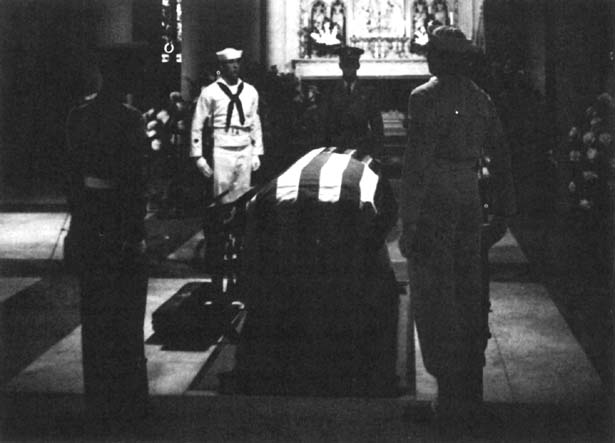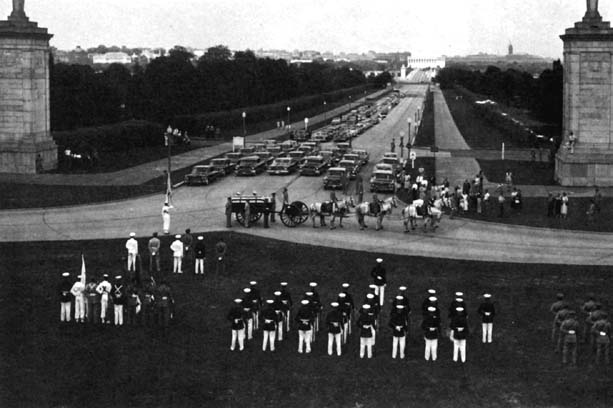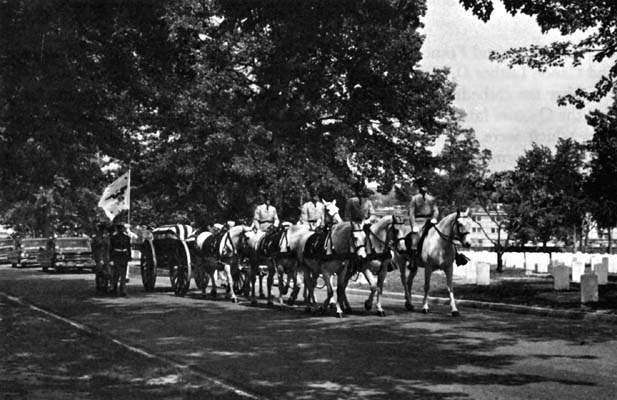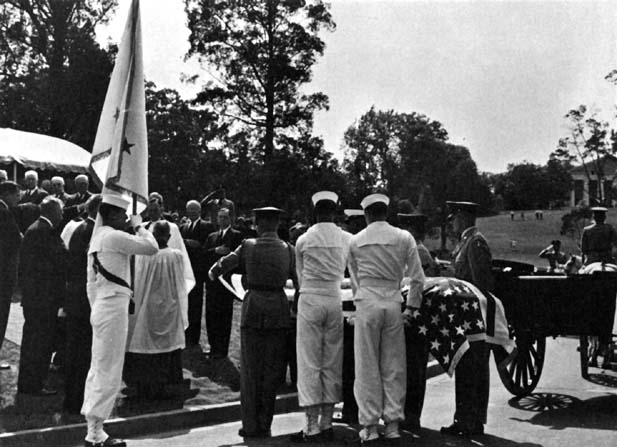Secretary of the Air Force
Deputy Secretary of Defense
Deputy Secretary of Defense in the Eisenhower Administration. He was scheduled to become Secretary of Defense on the retirement of Neil H. McElroy, when he died of a massive heart attack at his home in Washington on May 8, 1959.
In World War I, he served with the famed Rainbow Division in France.
After the war, he joined a division of Western Electric, which later became Bell Telephone Labs. Served with that company before entering government service in 1953, as First Assistant Secretary of Defense for Research and Development. In this post, he was responsible for billions of dollars worth of missiles and sattelite programs.
He became Air Force Secretary in 1955 and Deputy Secretary of Defense in 1957. He was the grandson of a Confederate soldier who died in a Union prison camp.
He is buried in Section 2 of Arlington National Cemetery.
Courtesy of the United States Air Force
DONALD A. QUARLES
Secretary of the Air Force from August 15, 1955 to April 30, 1957 Donald A. Quarles was the fourth secretary of the Air Force.
He was born in Van Buren, Arkansas in 1894. After completing high school, he enrolled in the University of Missouri Summer School at Columbia in 1910, 1911 and 1912, teaching mathematics in the Van Buren High School during the intervening seasons. Entering Yale University in 1912, he graduated with a bachelor of arts degree in 1916. He enlisted in the Army in May 1917, served two years in France and Germany, and was discharged with the rank of captain in the Field Artillery.
Employed as an engineer by the Western Electric Company during 1920 and 1921, Quarles studied theoretical physics as a part-time student at Columbia. Joining the Inspection Engineering Department of Western Electric in 1924 (which became Bell Telephone Laboratories the following year), four years later, he was in the Outside Plant Development Department, being placed in charge of this department the following year.
From 1940 to 1944, Quarles was director of the Transmission Development Department of Bell Telephone Laboratories which concentrated on military electronic systems, particularly radar. He was then appointed director of Apparatus Development, and in 1946, also became a member of the newly-established Department of Defense Committee on Electronics of the Joint
Research and Development Board and in 1949, he was named chairman.
In 1948, Quarles was designated vice president of Bell Telephone Laboratories. He was made vice president of Western Electric and president of Sandia Corporation, a Western Electric subsidiary which operates the Sandia Laboratory in Albuquerque, New Mexico, for the Atomic Energy Commission, on March 1, 1952.
On October 1, 1953, he was appointed assistant secretary of defense (research and development). Selected jointly by the secretaries of defense and commerce to be the first chairman of the reorganized Air Navigation Development Board in January 1954. Two months later, the president appointed Quarles a member of the National Advisory Committee for Aeronautics.
Quarles was given an interim appointment as secretary of the Air Force by President Eisenhower August 11, 1955, sworn into office August 15, 1955, and confirmed by the Senate February 16, 1956. He died in Washington, D.C. in 1959.
Deputy Secretary of Defense Donald A. Quarles
Special Military Funeral
8-12 May 1959
Deputy Secretary of Defense Donald A. Quarles, at the age of sixty-four, died in his sleep at his home in Washington, D.C., 8 May 1959. An autopsy performed at Walter Reed General Hospital on 9 May revealed that Secretary Quarles had died of a heart attack. He was given a Special Military Funeral, the first such ceremony to be conducted under revised funeral policies and plans issued in September 1958. As provided for in the regulations, Headquarters, Military District of Washington, received the primary responsibility for funeral arrangements.
These arrangements, made with close attention to the wishes of the Quarles family, called for Secretary Quarles’s body to lie in the Bethlehem Chapel of the Washington National Cathedral for twenty-four hours, beginning at noon on 11 May. The funeral service was to be held in the nave of the cathedral at 1400 on the 12th. By virtue of his service as an Army artillery officer in World War I, Mr. Quarles was to be buried in Arlington National Cemetery; the gravesite was in Section 2, about midway between Memorial Gate and the Memorial Amphitheater. Following the funeral ceremony, a hearse moving in a motor cortege was to carry the casket to the Memorial Gate of the cemetery. There, before a military escort standing in formation on the green, the casket was to be transferred to a caisson. The military escort was then to lead the cortege to the grave.
There were two departures from the 1958 regulations. The existing general plan called for the transfer of the casket from the hearse to the caisson at Constitution Avenue and 15th Street, N.W., in Washington and for the full procession to move to the burial site from that intersection. In this case, the transfer would take place at Memorial Gate and the full procession would march through the cemetery only. The general plan also called for an escort company from each of the armed services, but in the funeral of Mr. Quarles the military escort troop units consisted of one platoon each from the Army, Marine Corps, Navy, Air Force, and Coast Guard. These modifications (made without explanation in the Military District of Washington letter order for the funeral) emulated features of less elaborate “full honor” ceremonies employed by the Department of the Army under plans published in 1949 but now superseded.
Mr. Quarles’s body was taken to the Bethlehem Chapel just before noon on 11 May. Six body bearers (two Army, one Marine Corps, one Navy, one Air Force, and one Coast Guard), including the noncommissioned officer from the 3d Infantry who was in charge, handled the casket. The first relief of a joint guard of honor took post. The strength of the guard, forty-six, and its composition were precisely as prescribed in the 1958 plan.
On 12 May, the body bearers and forty-seven commissioned officers (majors, lieutenant colonels, or men of equivalent grades) who were to serve as ushers and guides reported to the cathedral at 1230. The twenty officers appointed as guides for dignitaries attending the service were all Army officers while the ushers formed a joint service detail of nine Army, three Marine Corps, six Navy, six Air Force, and three Coast Guard officers. In charge of ushers and guides was an officer from the Military District of Washington. Another detail of one officer and six men from the 3d Infantry arrived somewhat later to be on hand to transfer floral pieces to Arlington National Cemetery after the funeral service.
The ushers and guides had been briefed the day before on the seating arrangements. About a fifth of the 2,800 seats in the cathedral were allotted to the general public, and a few were set aside for members of the press. The remainder were reserved for the Quarles family and personal friends, the official funeral party, and other individuals invited to attend the service.
Heading the official party attending the service was Vice President Richard M. Nixon; President Dwight D. Eisenhower had chosen to attend only the graveside rites. Twenty friends and associates of Mr. Quarles were asked to participate as honorary pallbearers:
Neil H. McElroy, Secretary of Defense
Reuben B. Robertson, former Deputy Secretary of Defense
Wilber M. Brucker, Secretary of the Army
William C. Foster, former Deputy Secretary of Defense
Thomas S. Gates, Jr.,Secretary of the Navy
Allen W. Dulles, Director, Central Intelligence Agency
James H. Douglas, Secretary of the Air Force
Robert Cutler
Major General Robert W. Wilson (retired)
Robert B. Anderson, Secretary of the Treasury
Malcolm J. Baber
Dr. W. R. Lovelace, Sr
Lewis L. Strauss, Secretary of Commerce
Admiral Arthur W. Radford
Charles E. Wilson, former Secretary of Defense
J. Wright Taussig
Floyd Coffin
Dr. James R. Killian, Presidential Science Advisor
Dr. Frank H. McCloskey
Maxwell M. Upson
Also present in the cathedral as a special honor guard were the Chairman of the Joint Chiefs of Staff and the military chief and his deputy or assistant of each of the uniformed services.
Shortly before 1400, the body bearers brought the casket from the Bethlehem Chapel to the nave where they placed it on a movable bier. The two Army bearers then moved the casket to a central position in the nave. The Reverend Donald W. Mayberry, rector of St. John’s Episcopal Church in Washington, conducted the service, assisted by the Right Reverend Angus Dun, bishop of Washington, the Very Reverend Francis B. Sayre, dean of the Washington National Cathedral, and Canon Luther D. Miller, former Army Chief of Chaplains.
After the cathedral service, the body bearers carried the casket to the hearse and the Quarles family and members of the official funeral party entered automobiles which were to take them to Arlington National Cemetery. The military escort had formed on line on the green before the Memorial Gate at 1430 to await the arrival of the cortege. A caisson stood on the street in front of the military escort.
When the cortege reached the gate, it halted for a brief ceremony during which the casket was transferred to the caisson. The commander of troops, who in this instance was the commanding officer of the 1st Battle Group, 3d Infantry, then led the way via Roosevelt Drive to the gravesite. Behind the commander of troops and his staff of five (one field grade officer or the equivalent from each of the uniformed services) marched the US Air Force Band, which may have been chosen because Mr. Quarles once served as Secretary of the Air Force.
Behind the band was the column of Army, Marine Corps, Navy, Air Force, and Coast Guard platoons, each composed of a platoon leader, guide, and three squads of eight men each. Next came the joint color guard with the national colors and all of the service colors. The caisson itself, flanked by the body bearers, was followed by the personal flag, the honorary pallbearers, members of the Quarles family, and other mourners.
President Eisenhower arrived at the grave separately. Just as he took a seat behind the rows of chairs seating the Quarles family, two twelve-plane flights of jet fighters, one Air Force and one Navy, passed overhead. The flyover was planned and controlled by Headquarters Command, US Air Force, a procedure prescribed whenever aircraft from more than one service rendered a salute from the air. The Navy flight was staged from the nearby Naval Air Station and the Air Force flight from Andrews Air Force Base. Each group, flying at an altitude of 1,500 feet, passed over the gravesite in a formation of four-ship diamonds in trail.
Dr. Mayberry and Canon Miller conducted the graveside service. At its close, the 3d Infantry battery fired a 19-gun salute. A 3d Infantry squad then fired the traditional three volleys and a bugler blew taps, concluding the military honors for Mr. Quarles.
Mr. Quarles lies in State in the Washington Cathedral
Mr. Quarles’ funeral procession enters Arlington National Cemetery
Mr. Quarles’ funeral procession moves to the gravesite
Mr. Quarles’ casket is carried to the gravesite
QUARLES, DONALD AUBRY
CAPT 3 FIELD ARTY U S A
- VETERAN SERVICE DATES: Unknown
- DATE OF BIRTH: 07/30/1894
- DATE OF DEATH: 05/08/1959
- DATE OF INTERMENT: 05/12/1959
- BURIED AT: SECTION 2 SITE 4969-G R
- ARLINGTON NATIONAL CEMETERY
Michael Robert Patterson was born in Arlington and is the son of a former officer of the US Army. So it was no wonder that sooner or later his interests drew him to American history and especially to American military history. Many of his articles can be found on renowned portals like the New York Times, Washingtonpost or Wikipedia.
Reviewed by: Michael Howard




